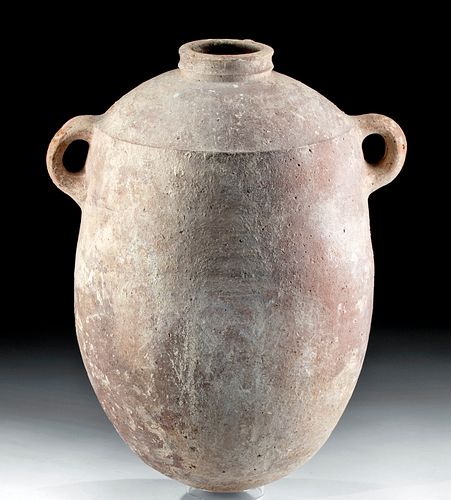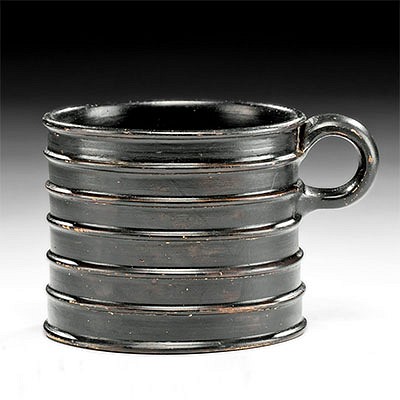Eastern Roman Terracotta Transport Amphora
Lot 50
About Seller
Artemis Fine Arts
686 S Taylor Ave, Ste 106
Louisville, CO 80027
United States
Selling antiquities, ancient and ethnographic art online since 1993, Artemis Gallery specializes in Classical Antiquities (Egyptian, Greek, Roman, Near Eastern), Asian, Pre-Columbian, African / Tribal / Oceanographic art. Our extensive inventory includes pottery, stone, metal, wood, glass and textil...Read more
Categories
Estimate:
$1,400 - $2,000
Absentee vs Live bid
Two ways to bid:
- Leave a max absentee bid and the platform will bid on your behalf up to your maximum bid during the live auction.
- Bid live during the auction and your bids will be submitted real-time to the auctioneer.
Bid Increments
| Price | Bid Increment |
|---|---|
| $0 | $25 |
| $300 | $50 |
| $1,000 | $100 |
| $2,000 | $250 |
| $5,000 | $500 |
| $10,000 | $1,000 |
| $20,000 | $2,500 |
| $50,000 | $5,000 |
| $100,000 | $10,000 |
| $200,000 | $20,000 |
About Auction
By Artemis Fine Arts
Mar 12, 2020
Set Reminder
2020-03-12 10:00:00
2020-03-12 10:00:00
America/New_York
Bidsquare
Bidsquare : Ancient / Ethnographic Around The World
https://www.bidsquare.com/auctions/artemis-gallery/ancient-ethnographic-around-the-world-4957
Ancient art from Egypt, Greece, Italy and the Near East, as well as Asian, Fossils, Pre-Columbian, Native American, African / Tribal / Oceanic, Spanish Colonial, Russian Icons, Fine art, much more! Artemis Fine Arts info@artemisfinearts.com
Ancient art from Egypt, Greece, Italy and the Near East, as well as Asian, Fossils, Pre-Columbian, Native American, African / Tribal / Oceanic, Spanish Colonial, Russian Icons, Fine art, much more! Artemis Fine Arts info@artemisfinearts.com
- Lot Description
Roman, Eastern Empire, Holy Land, Imperial Period, ca. 1st to 3rd century CE. A wheel-thrown pottery transport amphora of a sizable, round-bottomed form with tapering walls, a pair of applied loop handles, a sloped shoulder, and a squat rim surrounding the cavernous interior. Based on the shape, this amphora was perhaps used to transport stewed fruit or salted fish (larger examples typically contained wine or olive oil), however the lack of the original cork and pitch stopper means its original contents are unknown. Amphorae formed the basis of the Roman economy as storage vessels for transporting goods throughout the Empire, with examples found from North Africa to Britain. The rounded base on this amphora was meant for storage in soft ground; the handles made the amphora easy to load onto and offload from ships by placing it in a specially designed rack and roping it through the handles to others. Lucite display stand for photography purposes only. Size: 15" in diameter x 21.9" H (38.1 cm x 55.6 cm)
Provenance: ex-private prominent D.K. collection, New York, USA, acquired in the 2000s
All items legal to buy/sell under U.S. Statute covering cultural patrimony Code 2600, CHAPTER 14, and are guaranteed to be as described or your money back.
A Certificate of Authenticity will accompany all winning bids.
We ship worldwide and handle all shipping in-house for your convenience.
#153242Both handles reattached to upper body, with small chips to surfaces, and resurfacing with light overpainting along break lines. Nicks and abrasions to base, body, handles, and rim, with heavy encrustations commensurate with age and use, and areas of calcifications along exterior. Great earthen deposits throughout. Old inventory label beneath base.Condition
- Shipping Info
-
All shipping is handled in-house for your convenience. Your invoice from Artemis Gallery will include shipping calculation instructions. If in doubt, please inquire BEFORE bidding for estimated shipping costs for individual items.
-
- Buyer's Premium



 EUR
EUR CAD
CAD AUD
AUD GBP
GBP MXN
MXN HKD
HKD CNY
CNY MYR
MYR SEK
SEK SGD
SGD CHF
CHF THB
THB
















